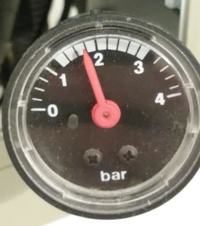During the last heating season I had to admit water to the CO system every day. No visible leaks. The flat in the block on the 2nd floor so after that time a neighbor downstairs would notice something.
I was refilling up to 1.5 bar. Temperature control knob set at 5 or 6 at night. In the morning (pressure which was over 1 bar), after reducing to 2 or turning off the heating, the pressure dropped quickly to 0.
I allowed water and used it for the last year.
Recently, the small ladder radiator in the bathroom stopped heating me. The reason was a blocked hose. When the pressure dropped to 0 I disassembled the hose and cleaned it.
After checking the diaphragm pressure, it turned out empty.
I closed the valve on the heating flow and return. Through the safety valve I drained the water from the container. I pumped up to 1 bar and drained the water again. I did this several times until the water flowed through the valve. I will add that at the end the water was very dirty, even BLACK.
I put the shadows in a container to 1 bar. I turned the cap on the valve. I turned on the supply and return what I filled the circuit with 1.5 bar pressure.
I vented the radiator in the bathroom (it hangs at the highest point).
All radiators heat, but very quickly (within an hour - no matter if the heating is used or not) the pressure drops to 0
I add water to the installation to 2 bar and slightly open the safety valve on the diaphragm vessel. I drain water into the container (it is very low - a few ml) until the pressure drops to 0. I fill the system very slowly.
In the vessel the air pressure was replenished on Friday and yesterday when I was checking the pressure on the valve it was the same as when it was filled (i.e. 1 bar).
Now I have to get up every 2 hours at night to supplement the water pressure in the circuit.
What can happen with the water allowed in the system. Why is it good for some time after topping up to 1.5 bar, and then falling to 0 later.
I was refilling up to 1.5 bar. Temperature control knob set at 5 or 6 at night. In the morning (pressure which was over 1 bar), after reducing to 2 or turning off the heating, the pressure dropped quickly to 0.
I allowed water and used it for the last year.
Recently, the small ladder radiator in the bathroom stopped heating me. The reason was a blocked hose. When the pressure dropped to 0 I disassembled the hose and cleaned it.
After checking the diaphragm pressure, it turned out empty.
I closed the valve on the heating flow and return. Through the safety valve I drained the water from the container. I pumped up to 1 bar and drained the water again. I did this several times until the water flowed through the valve. I will add that at the end the water was very dirty, even BLACK.
I put the shadows in a container to 1 bar. I turned the cap on the valve. I turned on the supply and return what I filled the circuit with 1.5 bar pressure.
I vented the radiator in the bathroom (it hangs at the highest point).
All radiators heat, but very quickly (within an hour - no matter if the heating is used or not) the pressure drops to 0
I add water to the installation to 2 bar and slightly open the safety valve on the diaphragm vessel. I drain water into the container (it is very low - a few ml) until the pressure drops to 0. I fill the system very slowly.
In the vessel the air pressure was replenished on Friday and yesterday when I was checking the pressure on the valve it was the same as when it was filled (i.e. 1 bar).
Now I have to get up every 2 hours at night to supplement the water pressure in the circuit.
What can happen with the water allowed in the system. Why is it good for some time after topping up to 1.5 bar, and then falling to 0 later.



